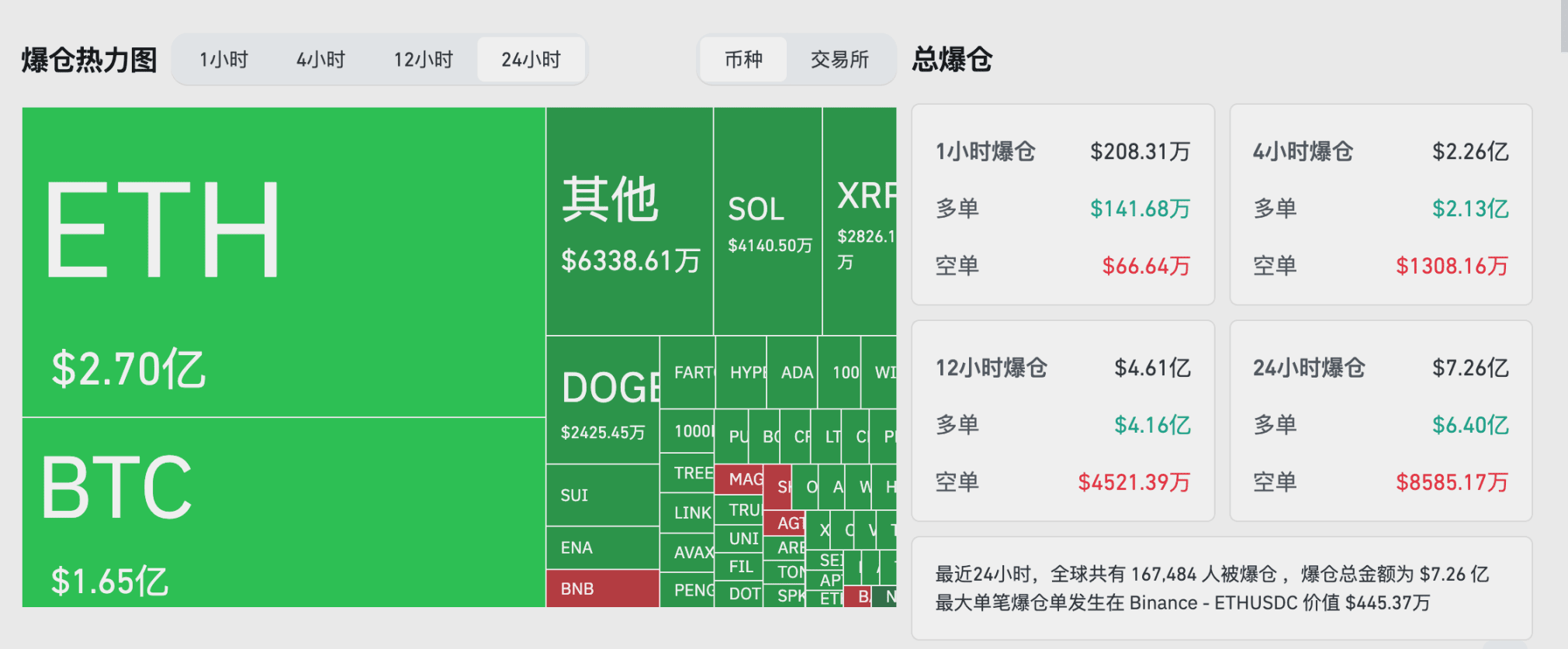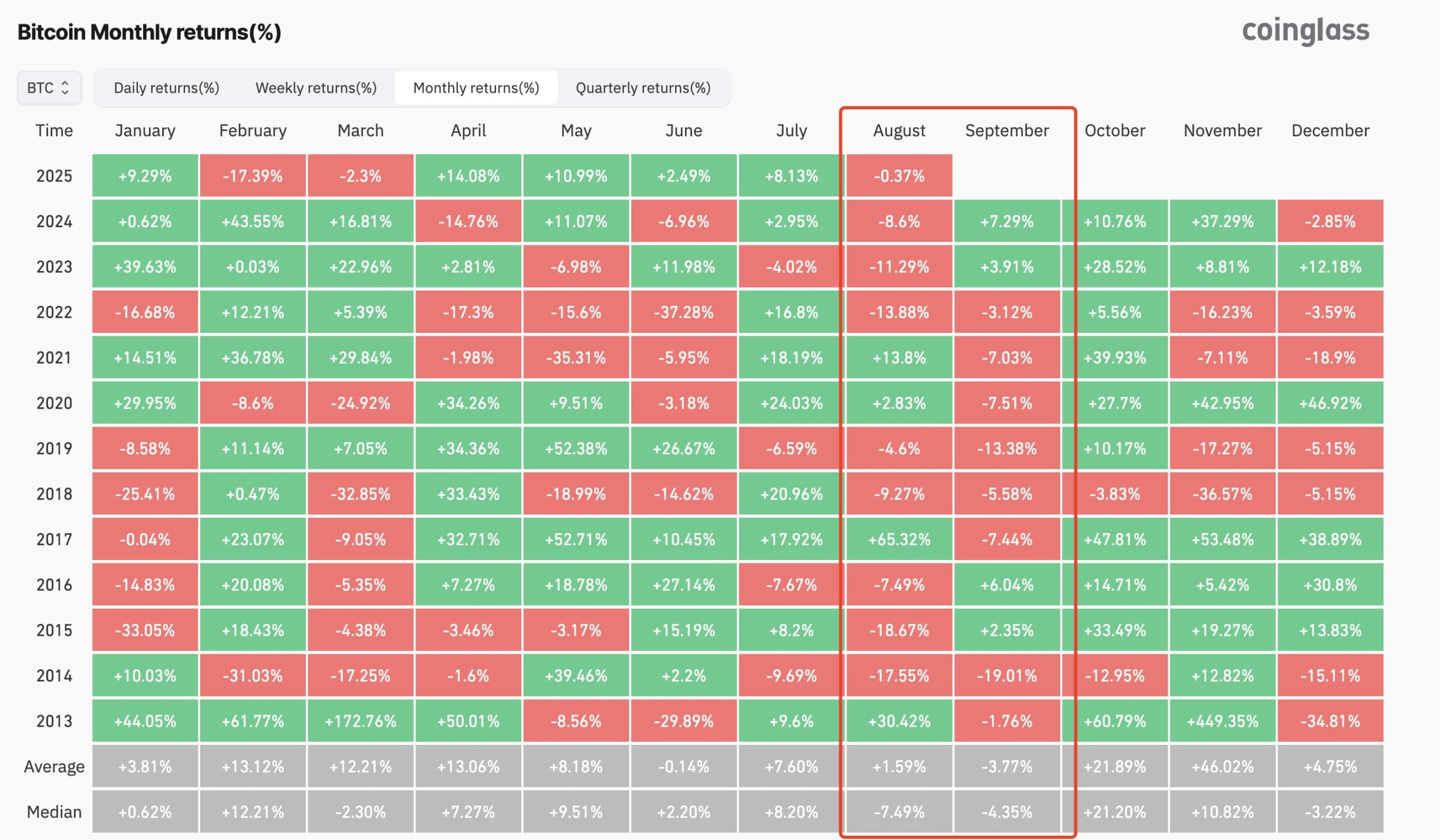On August 1, a major earthquake rocked global financial markets, and cryptocurrencies did not escape this calamity. Bitcoin (BTC) plunged sharply in the early morning, dropping to a low of $112,751, erasing nearly three weeks of gains and reaching a new low since July 10. By the time of writing, Bitcoin had slightly rebounded to around $113,639. Ethereum (ETH) also fared poorly, falling to around $3,431 in the early morning, breaking recent support.

Data shows that this crash has led to an enormous scale of liquidations—within the past 24 hours, the total liquidation amount across the network reached as high as $726 million! Of this, long positions accounted for $640 million, while short positions also saw $86.85 million in liquidations. Surprisingly, the liquidation amount for Ethereum reached $270 million, far exceeding Bitcoin's $165 million, indicating that ETH's short-term volatility is more severe and risks are greater.
Not only the crypto space but related U.S. stocks have also suffered heavy losses. Coinbase's stock plummeted by 16.7%, Riot Platforms fell by 17.75%, and Circle dropped by 8.4%. This indicates that under the current environment, investor interest and confidence in crypto assets are declining, and risk appetite is noticeably tightening.
Behind this round of turbulence are several heavyweight factors. First, the latest U.S. employment data performed poorly, far below expectations, raising doubts about the economic outlook. Second, Trump's strong reaction to the data release and his intense political rhetoric have further heightened market tensions. Additionally, the rising global geopolitical risks and increased risk-averse sentiment have led to a rapid withdrawal of capital from risk assets.
Overall, this violent market fluctuation is the result of multiple intertwined factors, including gloomy macroeconomic conditions, the impact of political storms, and rapid changes in investor sentiment. For ordinary investors, maintaining calm and managing risk is especially important in such a market.
Although short-term market volatility is high, many professionals still remain optimistic about the potential of cryptocurrencies in the long run, believing this is merely an adjustment period, with further opportunities ahead. In short, the path in the crypto space has never been smooth; fluctuations are the norm, and being prepared is essential for navigating through the storms.
Trump angrily slammed the employment data storm: ordered the firing of the head of the Bureau of Labor Statistics, escalating market turbulence!
On the evening of August 1, the U.S. Bureau of Labor Statistics released a bombshell: the number of non-farm jobs added in July was only 73,000, far below the market expectation of 104,000, marking the lowest growth since October of last year. Even more shocking was the significant downward revision of the data for the previous two months, which collectively reduced jobs by 258,000! This caused the market to explode instantly, with investor sentiment becoming suddenly tense.
In response, Trump reacted extremely fiercely, angrily criticizing Biden's appointed head of the Bureau of Labor Statistics, Erika McEntarfer, on social media, accusing her of manipulating employment data before the election, stating that 'the non-farm data was deliberately fabricated to undermine me.' Shortly after, he ordered the immediate firing of the director, appointing William Wiatrowski as acting director.
Trump emphasized: "Key economic data must be real and fair, and cannot serve politics." He also criticized the Federal Reserve for making two significant interest rate cuts before the election, implying that Chairman Powell should retire. Shortly after, Federal Reserve Governor Kugler announced his resignation, leaving space for Trump to nominate his preferred candidate, potentially leading to significant changes in Federal Reserve monetary policy.
This 'data storm' has triggered strong fluctuations in global markets, especially intensifying turmoil in the crypto market. Weak employment data has undermined investor confidence, raising concerns about economic growth slowing down, and the Federal Reserve's stimulus policies may tighten. Trump's political maneuvers add further uncertainty, leading to increased risk-averse sentiment.
Geopolitical tensions are escalating, and August welcomes the 'downfall devil month' for Bitcoin!
Not only are economic data making the market tense, but geopolitical risks are also adding fuel to the fire. Trump spoke out on social media, ordering the deployment of two nuclear submarines to the waters near Russia in response to the 'provocative remarks' of former Russian President Medvedev. This hardline action immediately shocked global markets.
As a result, the three major U.S. stock indices fell sharply, with the U.S. stock market losing over $1 trillion in market value in a single day, it truly 'evaporated'! Meanwhile, risk-averse sentiment surged, and gold prices soared past $3,350 per ounce, rising to $3,362, becoming a safe haven in the market.

Speaking of the crypto space, everyone should pay more attention—August has never been a 'good friend' to Bitcoin. According to statistics from Lookonchain, in the past 12 years, Bitcoin has experienced declines in 8 of those years during August and September, with a probability as high as 67%, making it the 'downfall devil month.' This means that the BTC you hold is at greater short-term volatility risk, and investors need to be more cautious.
In summary, the combination of weak economic data, geopolitical tensions, and traditional 'seasonal patterns' suggests a tumultuous August market. Crypto enthusiasts, during this time, must maintain a steady mindset, pay attention to risk management, and avoid blindly chasing highs and selling lows, preparing for potential volatility.
The market is facing a critical turning point: short-term pullback or long-term consolidation?
The current market stands at a crossroads: is it a temporary pullback or the beginning of a long-term consolidation period? This has become the most concerning question for investors. Recently released weak employment data from the U.S. has significantly increased market expectations for a rate cut by the Federal Reserve in September. According to CME's 'FedWatch', the probability of a 25 basis point rate cut in September has risen to 89.8%, almost a certainty, while the possibility of maintaining the current rate is only 10.2%. Additionally, the probability of a cumulative 50 basis point rate cut in October has climbed to 51.8%.
From a macroeconomic perspective, weaker-than-expected employment data provides space for the Federal Reserve to cut rates, which should benefit risk assets, including cryptocurrencies. Simply put, a rate cut means lower borrowing costs, making it easier for funds to flow into the stock and crypto markets, driving prices up.
However, market volatility still carries uncertainty. In the short term, investors may choose to take profits due to the data shock, leading to a price drop, forming a healthy short-term pullback. This pullback helps digest previous gains, repairs market structure, and prepares for the next round of increases.
On the other hand, if market sentiment remains low, the macro environment unstable, and investor confidence insufficient, the pullback may extend, leading the market into a consolidation phase, with limited price fluctuations while waiting for new positive news or significant event triggers.
For newcomers in the crypto space, there are two key points to focus on: first, closely monitor the Federal Reserve's policy direction and economic data, and second, reasonably control positions to avoid chasing highs and selling lows. Maintaining patience in the short term, managing risks, and waiting for market clarity are essential.
Overall, despite the current price fluctuations, expectations for a rate cut by the Federal Reserve bring hope to the market. The coming weeks will be a crucial moment for market direction. A steady approach is the best strategy to navigate the current market.

